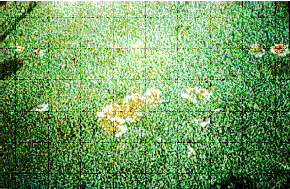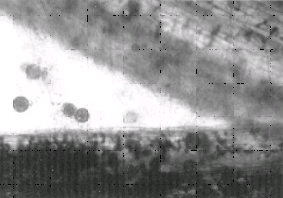|
Pythium blight, also known as grease spot, spot blight, and cottony
blight, is caused by 15 or more species of soilborne fungi in the
genus Pythium, especially P. aphanidermatum (P.
butleri) and P. graminicola. All cultivated turfgrasses,
especially bentgrasses, annual bluegrass, and ryegrasses are susceptible
to attack. Pythium blight can be devastating during hot (80 to 95
F or 26 to 35 C), wet, or very humid weather when the grass is dense
and lush and there is little air movement. Minor attacks of Pythium
blight can occur at cold or cool temperatures in winter, spring,
and fall during prolonged wet weather when temperatures are 60 to
65 F (10 to 18 C). The disease is usually most severe on heavy (fine-textured),
poorly drained soils. During hot (90 to 95 F or 32 to 35 C), very
humid weather, an outbreak of Pythium blight may develop and spread
very rapidly, killing large areas of seedling or established turf
overnight.
Back to Top
|

Figure
1.
Pythium blight spots on Kentucky bluegrass.

Figure
2.
Straw colored spots, caused by Pythium, on leaf blades of Kentucky
bluegrass.
|
Symptoms
Small, distinct, round to irregularly shaped, sunken spots, which
are generally one to two inches (2 to 5 centimeters) in diameter
or as large as 6 to 12 inches (15 to 30 cm), suddenly appear during
hot or cool, very wet, calm weather. The grass leaves at first are
water-soaked, slimy ("greasy" to the touch), and dark
during the early morning. They quickly fade from reddish brown to
a light tan as the grass blades dry out and shrivel and become matted
(Figure 1). Clusters of blighted plants may merge to form large
irregular areas 1 to 10 feet in diameter or to form long streaks
up to a foot or more wide. The patterns apparently develop because
spores and mycelium of the Pythium fungus (or fungi) are
easily spread by surface drainage water, foot traffic, and by mowing
when the grass is wet. When the air is moisture-saturated, especially
at night or in the early morning, the watersoaked grass leaves collapse
and appear matted together by a fluffy, white to purplish gray,
cobweb by mass of fungus mycelium–hence the name cottony blight.
If the growth of the Pythium fungus is checked by a sudden drop
in temperature or humidity before entire leaf blades are blighted,
distinct straw–colored spots or lesions develop. These spots
resemble those of dollar spot but do not have brown or reddish brown
borders. Pythium-infected grass blades commonly twist, collapse,
and die (Figure 2).
Grass seedlings affected with Pythium blight develop a watery rot,
or they may wilt, collapse, and die (damp-off) in irregular patches.
This condition is very common in a seedbed that is overly wet or
waterlogged and where surface drainage is poor.
Species of Pythium cause more root rot and damage to the
crowns of grass plants in cool (60 F or 15 C), warm, and hot weather
then is generally recognized, especially in highly maintained golf
putting greens and home lawns. Pythium aristosporum, p. arrhenomanes,
and P. periplocum colonize the secondary roots of creeping
bentgrass in golf greens. Infection results in slower growth, an
off color to the grass, stunted white or discolored roots, a general
decline, and a thinning out of plants. Pythium blight is often followed
by other organisms such as blue and green algae and species of Bipolaris,
Curvularia, Drechslera, Exserohilum, Trichoderma, and other
fungi. There is also some evidence of a close association between
species of Pythium and certain plant parasitic nematodes.
|

Figure
3.
Oosores of Pythium sp. in bentgrass leaf tissue as seen under
a high power microscope (Dr. G.W. Simone).
|
Disease Cycle
Species of Pythium are water-mold fungi that are common in the grass
thatch or mat and are widely distributed in many soils. Besides P. aphanidermatum
and P. graminicola, other species of Pythium that may kill or blight turngrasses
include P. afertile, P. aristosporum, P. arrhenomanes, P. catenulatum,
P. debaryanum, p. dissoticum, P. irregulare, P. iqayamai, P. myriotylum,
P. periplocum, P. rostratum, P. torulosum, P. ultimum, P. vanterpoolii,
and P. vexans. Only an expert with a good compound light microscope
and the right stage of fungal development can identify species of Pythium
(Figure 4); two or more species may be present and killing turf at any
one time.
Pythium fungi are commonly present in diseased turfgrass, thatch debris,
and soil in the form of delicate, nonseptate mycelium and round, thick-walled
resting spores (oospores) embedded in dead grass tissue. Under favorable
temperature and moisture conditions, the mycelium resumes rapid growth
while the oospores germinate to produce sporangia (bearing conidia) or
hyphae. The sporangia, in turn, may germinate to produce either motile
zoospores or hyphae. All spores can germinate and produce hyphae capable
of infecting grass plants within an hour or two.
Living and dead grass plants that were invaded earlier in the season
or during the previous season commonly serve as infection centers as disease
develops by means of a cobweb like, hyphal growth of the fungus from leaf
to leaf and plant to plant. Rapid growth occurs when oospores and zoospores,
diseased plant parts, or Pythium infested soil, which is moved
by mowers, maintenance equipment, surface water, shoes, or animals, spreads
the disease.
The blighting of grass and the growth of Pythium species are most
rapid and severe in moisture-saturated air when air temperatures are 85
to 95 F night. At temperatures of 90 to 95 F (32 to 35 C) a much shorter
time is required to destroy a stand of grass completely. Pythium blight
is especially severe in dense lush grass in low-lying areas that have
poor soil drainage and air movement. Disease may become more severe in
alkaline soils than in acid soils. Algae often invade diseased patches
and may produce a hard dark crust.
Disease development is greater with a thatch exceeding 3/4 inch thick
and with high nitrogen fertility or a high level of balanced fertility
than with a low fertility level. Some species of Pythium are most active
when temperatures are 52 to 70 F (11to 21 C) and others are dominant at
73 to 93 F (23 to 34 C).
Back to Top

Figure
4.
Nine species of Pythium that cause diseases of turfgrasses as
seen under a good light microscope: (a) various types of sporangia;
(b) types of sex organs (oogonia with oospores and antheridia)
(drawing by Lenora Gray).
|
Control
1. Provide for good surface and subsurface drainage when establishing
a new turf area. Eliminate low spots where water may stand. If soil
amendments such as peat moss, calcined clay, sand, topdressing,
and compost are added, mix those uniformly into the soil. Test the
soil reaction (pH) and follow suggestions in the soil report. A
pH level between 6 and 7 is best.
2. Do not overwater. Water as infrequently as possible for good
gaseous exchange between the air in the soil and that above it.
Avoid frequent light sprinklings, especially in the late afternoon
or evening. During summer or early fall drought periods, water established
turf infrequently and deeply, moistening the soil at each watering
to a depth of six inches or more.
3. Buy top quality seed, sod, sprigs, or plugs from a reputable
dealer. Sow seed treated with captan or thiram plus Koban or Apron.
Seed at the suggested rate. If possible, plant when the weather
is cool and dry. The seedbed should be well prepared and fertile.
Avoid overwatering, especially from the time of seeding, plugging,
or sprigging to seedling emergence or plant establishment. Water
early in the day so the grass can dry before night.
4. Avoid mowing when the grass is wet and periods of intense disease
activity and foliar mycelium is evident. Severe damage from Pythium
root rot may be minimized by increasing the mowing height.
5. Maintain a proper balance of nitrogen, phosphorus, and potassium
(H-P-K) according to local recommendations and soil test reports
which vary with the kinds of grasses grown and their use. Do not
over fertilize, especially with a water-soluble, high nitrogen source
in hot weather. Use slow-release nitrogen sources during spring
or summer fertilizations.
6. Increase light penetration, air movement, and rapid drying of
the grass surface by pruning or selectively removing dense trees
and shrubs bordering the turf. Space landscape plants properly to
allow adequate air movement and to avoid excessive shade. Some golf
courses employ large electric fans to circulate air around secluded
putting greens.
7. Remove thatch in early spring or late summer when it has accumulated
to 1/4 to 1/2 inch using a vertical mower, power rake, aerifier,
or similar equipment which can be rented at garden supply or tool
rental stores.
8. Follow suggested weed-control programs for the area and for
the grasses grown.
|
9. There are no known resistant cultivars of any turfgrass species except
bermuda grass, which is only adapted to areas of the southern third of
Illinois. Most of the improved cultivars of the latter grass (e.g., ‘Everglades',
‘Florida 50', ‘Texas 22', ‘Texturf', ‘Tiffine', ‘Tiflawn',
and ‘Tifway') are highly tolerant to Pythium blight when mature.
10. During extended periods of hot, wet weather, a preventive
fungicide spray program will be needed when the cultural practices outlined
above (1 through 9) do not check the development of Pythium blight. The
first spray application should be made as soon as night temperatures are
expected to remain at 68 F (20 C) or above, when daytime air temperatures
are 80 F (27 C) or higher, and when the forecast is for continued wet
or very humid wether. Depending on the fungicide used, repeat applications
as needed at 5- to 21-day intervals as long as the weather stays hot and
humid. For the most effective control of Pythium blight on established
turf, uniformly spray 1,000 square feet of turf with the proper fungicide
mixture using 10 gallons of water. For fungicide recommendations consult
chapter 13 in the current edition of Illinois Urbana Pest Management Handbook.
The fungicides suggested for control of Pythium blight may be alternated
with another fungicide to control brown patch, dollar spot, or other diseases
to give broadspectrum disease control.
To control Pythium blight on new seedlings, apply Banol L, Subdue 2E,
Koban, or Terrazole at the suggested rates immediately after seeding.
Repeat within 5 to 7 days if the soil is wet and environmental conditions
remain favorable for disease development. When mixing or applying any
fungicide, carefully follow the manufacturer's directions and precautions.
Back to Top
|



